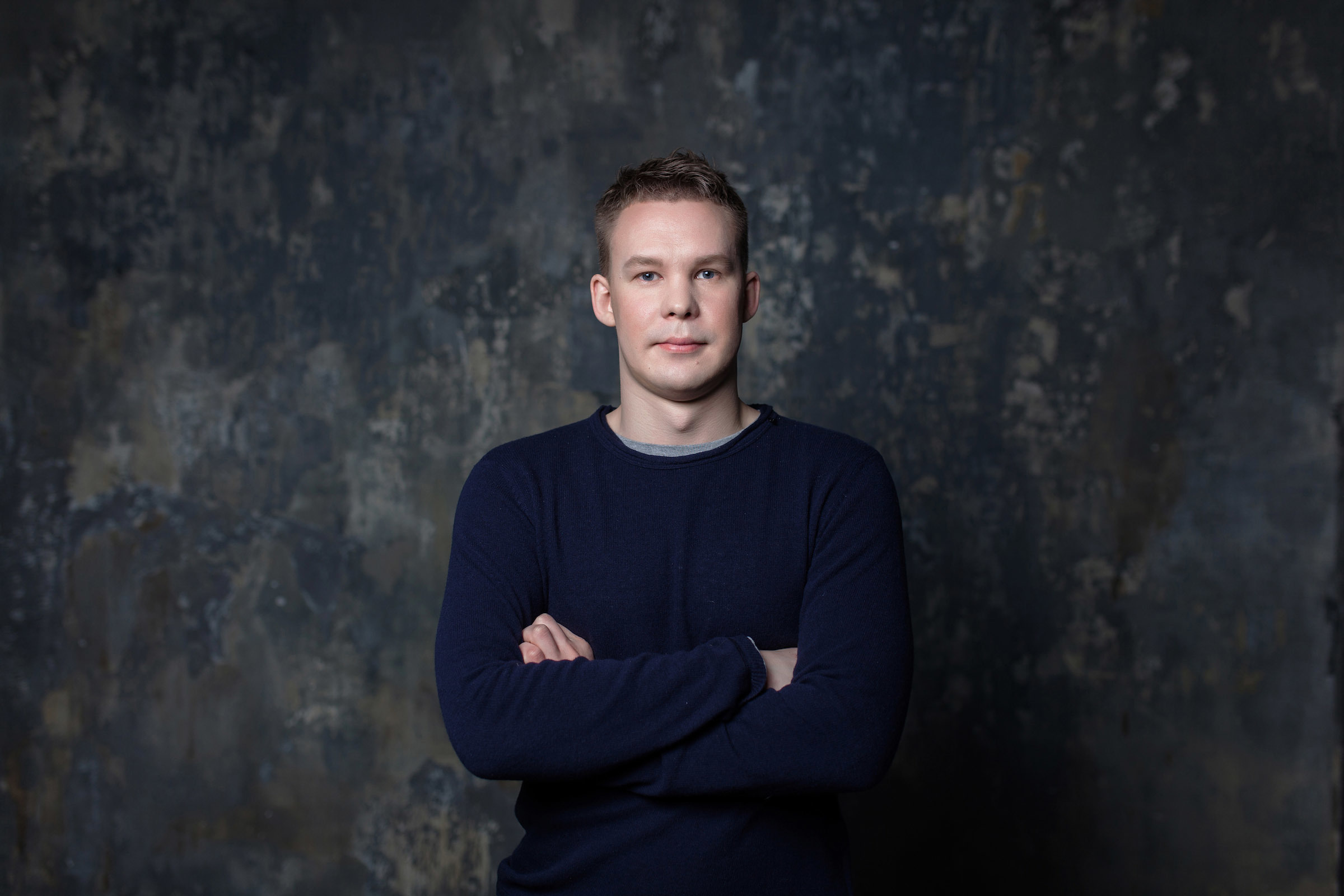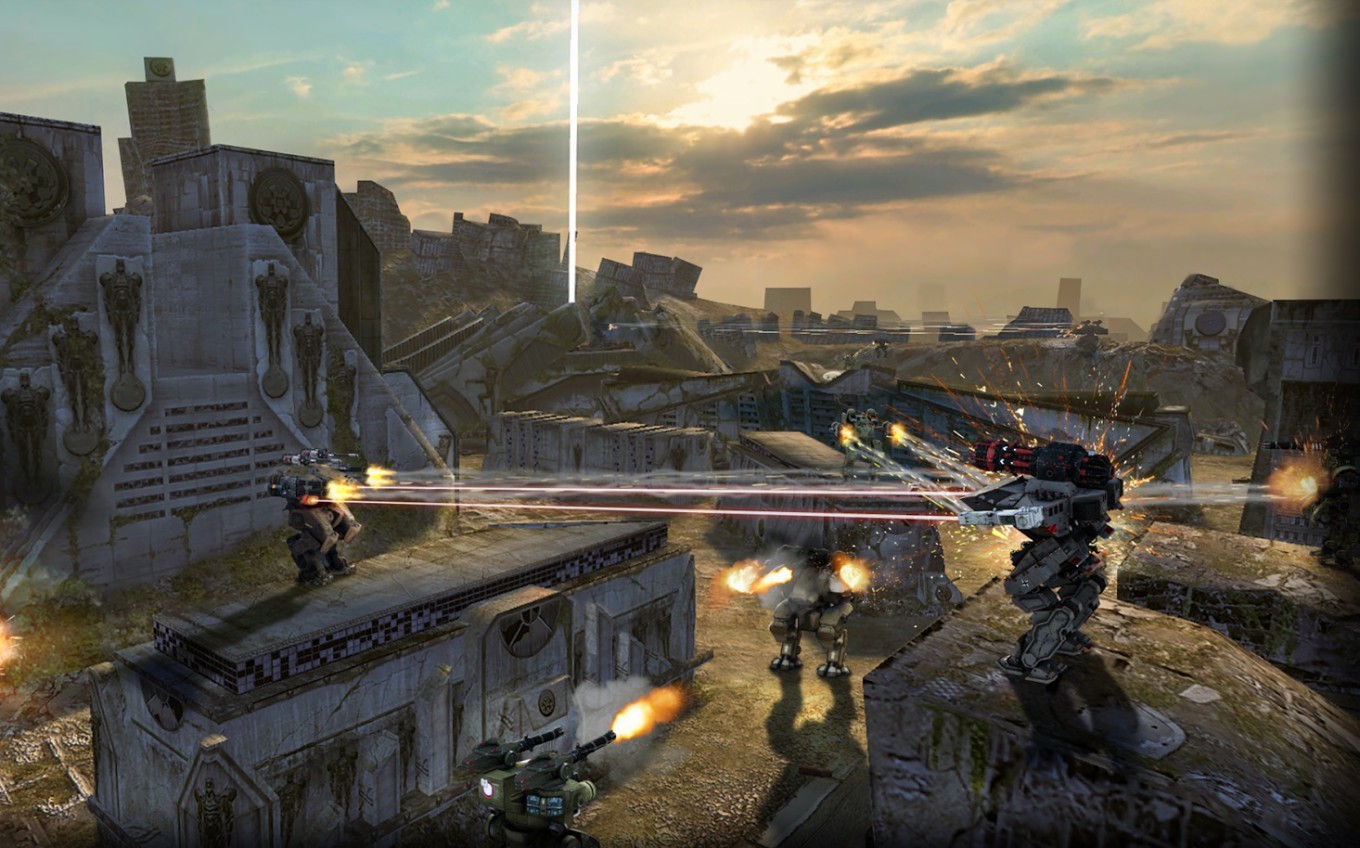Philipp Gladkov: WWR confidently approaching revenue of $1 million

Sergey Babayev, the mentor of “Games Market” rubric at VC.ru, sat down with Philipp Gladkov, head of Pixonic (the game studio behind Walking War Robots), to talk about how he came into the gaming industry, the confidence one must have in a game’s potential success, as well as risks, revenues, and the company’s plans for the future.
Sergey Babayev: Hi, Philipp. Pixonic has been in the market for a fairly long time; I remember some of your past hits – “Domovyata” spring to mind, among others. You recently returned to the playing field with Walking War Robots, which quickly became a mobile hit. To my mind, this recent success is associated with the studio’s new leadership and vision – in other words, with yourself. Let’s try and figure out how you got to this point, and how you became part of the industry in the first place.
As far as I understand, you didn’t have any experience in game development prior to Pixonic – what were you doing before you joined the studio?
Philipp Gladkov: It turned out funny – I took part in Starcraft and Warcraft 3 tournaments back in my school days, and indirectly ended up in game development around 2004–2005. Then me and Igor Klyukin (the current Pixonic COO – Ed.) were playing “Territory”, and I had my own clan of about 50 people – “Cyberpunks”, we called it. By the way, the experience I got then – managing such a large group of people, creating a website and organising meetings offline – really helped me out in the future. Me and Igor had a lot ideas about improving the game, and in the wake of this, we met with Igor Matsanyuk (member of the board of directors of Game Insight, co-founder of the IT Territory studio) and Sergey Zhukov (lead signer of “Ruki Vverh”, co-founder of the IT Territory studio – Ed.), they were still working for the company back then.
Later on, Igor Klyukin got a job at IT Territory, and I went my own way. I created Playit.ru – an online portal about games. At that time, people weren’t that into websites in general, and the fact that they were game-related made it even stranger – I often got looks that clearly read: “Sites? Games? Are you actually doing something or are you fooling around?”.

Then I sold the site to Woh, who sold it further on to IT Territory – for a couple of years the site served as a gateway for all of IT Territory’s games. I still have a job offer from Alice Chumachenko in my inbox – they wanted me to work for them – but the offer’s still there, and it’s nothing but a memory at this point. After that, I told myself that this wasn’t serious, it was all games, and I went on to involve myself in internet startups. But, as we all know, life is very ironic – I returned to game development in 2010, when I joined Pixonic after being invited by its founder, Lena Masolova.
For what position did she bring you in? What was your initial role?
When I started working for Pixonic, the firm only had six employees, and I was responsible for working and communicating with our partners. Subsequently, the number of employees grew significantly, and my goal was to release our games and other developers’ projects to the maximum number of social networking sites – German, Polish and so on. This was before Facebook started completely dominating the market.
In the summer of 2011, I moved to the position of COO, and took over the company in 2013. If I told you everything was easy, I’d be lying – there were a lot of difficulties, it was a real emotional rollercoaster. I had a lot of ambition, and little initial experience. Now I have a lot more experience, but the rollercoaster’s still there – the market’s changing, as are working conditions, and we’re not giving ourselves any room to relax either.
Still, as the company passed over to you, it came with a certain number of “genes” that accumulated over the years of its existence.
In general, I would divide my stay at the company into several periods. At first, I eagerly absorbed all the information, studied the market, and carefully looked towards products and strategy.
Then I began implementing this approach in the role of Executive Director – the beginning of my impact on the company can be dated to that moment. These were cautious steps, there were some changes in personnel; some leads (lead developers – Ed.) left, people that were with the firm since its inception, and new employees took their place. Interestingly, only five of the “founders and grandfathers” are left.
Did the company enter a more active phase of renovation after you became CEO?
Yes – after I became CEO, the firm began going through radical changes. In my opinion, we created a completely new Pixonic based on the best features of the old firm over the past five years. The passion for analytics is also still there. Overall, the new Pixonic is made up of strong professionals with similar values.
I have always supported open communication and openness to change – that is what allows us to keep moving forward, avoiding stagnation. I’m in somewhat of a panic now – from a “warm lamp” start-up of 40 people we’ve grown to an average of nearly 100 employees spread out over three offices in Berlin, Moscow and Belgorod. We’re renovating our Moscow office at the speed of sound – in our current set-up we’re literally “sitting on each other’s heads”, and still delivering 150% growth, although something tells me that at the current pace of development, these numbers will seem small in little over a year. My most important goal is to sustain future growth without losing our flexibility and openness.
By the way, why are there so many people involved, and what is the need for offices in Belgorod and Berlin? Are these actual offices or are they merely representative?
Walking War Robots are now developing actively – sustaining and developing such rapid growth requires a large number of employees. Of course, we’ll also be moving in the direction of new titles.
The Belgorod office was opened in 2012 to support the Robinson game. It now employs more that 11 people, but they’re working on Walking War Robots. We’re only just starting to open our Berlin office, and we’re planning to attract 8–10 employees there. We don’t have representative offices – each one of our offices opens up with a specific task in mind.
Let’s move on to Walking War Robots – your action game about fighting robots. Did you have any concerns about narrowing the potential audience due to the dangerous setting of the game?
In fact, there was a paradigm shift in the firm before the “Robots” came about. Previously, if we were hyped up and started making social and mobile games, we had a simple formula – plant 10 projects, one of which will grow and become like “Domovyata”, which were on Odnoklassniki’s top–10 for 3 and a half years. Or the aforementioned Robinson, which easily scored half a million downloads, and still brings in money after four years, without any support.
Now we’re concentrating on developing a hit from square one. We invest our efforts and expertise into one project – we recently wrote about this on VC.ru. We’re ready to make prototypes and throw them out several times until we’re happy with the final product. We have now learned that our expertise at the intersection of shooters and MOBA is growing, and we’ll begin to use it in future projects. Apart from this, we will gain new experience while developing other projects.

You know, I often hear about the rapid prototyping model, but I haven’t seen any successful examples. Could you tell me about the prototypes you tried and why they didn’t make the final cut?
I’ll have to lift the curtain on our “inner kitchen”, so to speak. By hiring a product manager to a certain job, we’re offering him to defend the idea of a new product – or we already have an idea, and we’re checking whether this person will be able to implement it. At the time of the “Robots” launch, several executives defended the idea. After successfully defending their ideas, we allocated resources and time to develop a prototype to understand how it “looks and feels”.
The team that made the “Robots” prototype was pretty experienced, and had worked on a similar project earlier on. After we played this prototype for the first time, we instantly started thinking – “what if we added new robots, guns, or maps?”. This is exactly what we were looking for – a game that evoked emotions, and, therefore, had the potential to be successful.
The game has to drag you in at the prototype stage, otherwise it’s not worth investing in – that’s the gist of our approach. Naturally, it works better if the team behind a given prototype has already worked on that specific genre.
So the “on-the-dice” prototype has to captivate you with its dynamics? I often meet young teams that don’t have the initial chemistry, and yet they paint a very bright final picture – they tell me that it’ll all be amazing once they “change the physics, and tweak the art”. Do you believe in this magic?
I don’t buy this “magic” at all – I regularly talk to external investors and teams, and haven’t observe any success stories of this kind.
How many people worked on the project in total? And if it isn’t a secret, how much does it cost to develop a similar product – could you give me a ballpark figure?
In general, it is not a secret that the development of a fully-fledged mobile project would cost around $500 thousand at the current exchange rate, or $1 mln. at the old exchange rate. This is a very rough – but correct – estimate. Three people were involved in Walking War Robots at the initial stages – now there are over 50 professionals working on the project.
We are not one of those companies that launch a project, collect the money, and make a new one. On the contrary – we operate with our products, and develop them over several years. Therefore, the project’s cost isn’t as important as the the potential market share that we can get.
As far as I can remember, at Google Mobile Day you talked about the growth rate of the application’s user base – can you share those details with our readers?
The project is growing, both in terms of downloads and revenue. According to our numbers, we’ve already reported about 5 million total downloads on iOS and Android in November, which brings us to around 9 million downloads in total. The distribution among platforms is approximately the same – that being said, we only launched our App Store game in April 2014, and the Google Play version came out several months ago.
Is this growth organic, or do you have an advertising budget?
Organic growth is our bread and butter – actually, any cool game which naturally collects good ratings won’t go unnoticed by ordinary gamers, or by Google and App Store, who will shower it with features.
We’re actively working in this direction, but we understand that the mobile market has grown. It’s become crowded and hot, and we’re actively working with our budgets – we have 12 marketing specialists who are hoarding in traffic from every direction. We can still show solid earnings on a given game without spending any additional funds, but people are paying for our product, and paying a lot, which makes us focus on expensive, high-quality traffic.
Very good indicators indeed. Since we’ve started talking more openly – what are the revenues in question?
In terms of income per month, we mentioned our November figures – $668 thousand, but we’re confidently approaching the mark of $1 mln. a month. The three main objectives now are playing fairly, playing together, and carrying out an extensive “metagame”. We’re not going to strengthen the project’s monetisation – we plan on continuously increasing its quality.
What’s your take on the advertising model? What is your IAP (in-app purchases – Ed.) to AD ratio?
We have a very positive outlook in the advertising model, but we only use it after we’ve finished our active development phase, having transitioned the project over to the support teams. As of now, Walking War Robots is only earning off its IAP.
If you grow the revenue and your audience, then even the international charts will start showing a positive dynamic.
This is very true – the charts from AppAnnie for the US, UK and Japanese markets clearly indicate that the further we go, the higher up we are on the “Grossing” charts, and not vice versa:



Let’s talk about marketing – a vital issue for practically any mobile developer. As far as I understand, you reinvest a tangible part of your earnings into buying traffic. In your opinion, is there an optimal percentage of earnings that one should reinvest in marketing? Or should you just “pour it on” while you still have the chance?
We keep buying traffic as long as it’s generating returns. If we see an excellent source which “bounces back” after a month or two, we can “pour on” a million [dollars] more, although the game is currently generating less than that. For me, it’s psychologically comfortable to reinvest no more than 40–50% of our earnings.
So that means the budget isn’t limited, strictly speaking?
Correct – we don’t limit our budget in accordance with a predetermined CPI, a preset monthly budget or a certain number of downloads. The most important thing is that the traffic brings in positive ROI – if it continues bringing it in, we increase its volumes, so long as it remains profitable. Does this seem aggressive? Yes, but this is a great project, and it’s fully worth it.
After discussing Walking War Robots, both in this conversation, and in others, I get a feeling that this project was a “make or break” deal for the company – is this so?
I can safely say that it was – we planned to go “all in” after changing the company’s paradigm.
We kept in mind that this was the project that was going to “make it”, so to speak. If it didn’t go as far as it did, then I would’ve probably left the gaming industry thinking that I don’t understand a damn thing about the market.
At that time we only had two project slots – the first was the support of Robinson, and the other was Walking War Robots. In fact, we had given up all the other projects, and had zeroed in on a single opportunity.

Let’s switch topics for a little bit – according to your Facebook page, it’s evident that you’ve moved office and carried out extensive renovations. Is this distracting you from your real goals, and are these betterments at all premature?
It’s all very simple – as of now, we have 400 sq. m. for about 80 employees. Plainly speaking, this is very uncomfortable. We have more than 10 vacancies available, and there’s simply no place to put them. We are now moving to a new office with more that 1400 sq. m. of available space, which can accommodate over 120 employees.
A change of office is a real need for our company. In a very short period of time, I was able to look at over 50 offices wit my team, and we made a great choice. We only had two months to move and renovate our new office – we’re not talking about any major investments here, the main thing is that it’s convenient and comfortable.
A further question, then – you recently said that you became a publisher. In fact, as we mentioned earlier, Pixonic has a pretty long history, and you were already a publisher at one point in your career, which gives rise to a mass of questions. Why are you veering back into this river?
We have gained a great amount of expertise in the field of shooter and MOBA projects, and are continuing to expand it further. We have also built a powerful marketing machine to promote such projects. Therefore, we can begin promoting our new projects in this niche with a certain degree of ease.
Do you have any time to play anything on top of all your projects?
Indeed – I periodically play Hearthstone and League of Legends. At one time I was interested in Dark Souls – for me, that was the definition of hardcore.
Can you recommend our readers any useful industry-related reading material?
Currently I get all my information from the domestic and foreign gaming communities, as well as vc.ru, App2Top, AppTractor and Apps4All. I used to binge-read business books from “Mann, Ivanov & Ferber”, but that interest somehow disappeared.
I’m always accumulating new literature and adding things to my “to-read” list, but I keep going places in my spare time, and when I’m travelling, I pull out my phone and check my work e-mail, which is practically never empty. I’m working hard to carve out spare time to immerse myself in literature – next time, I hope I can recommend some specific books.
We’ll round off with our usual question: how do you travel?
I use Gett, the Metro, and I bike.